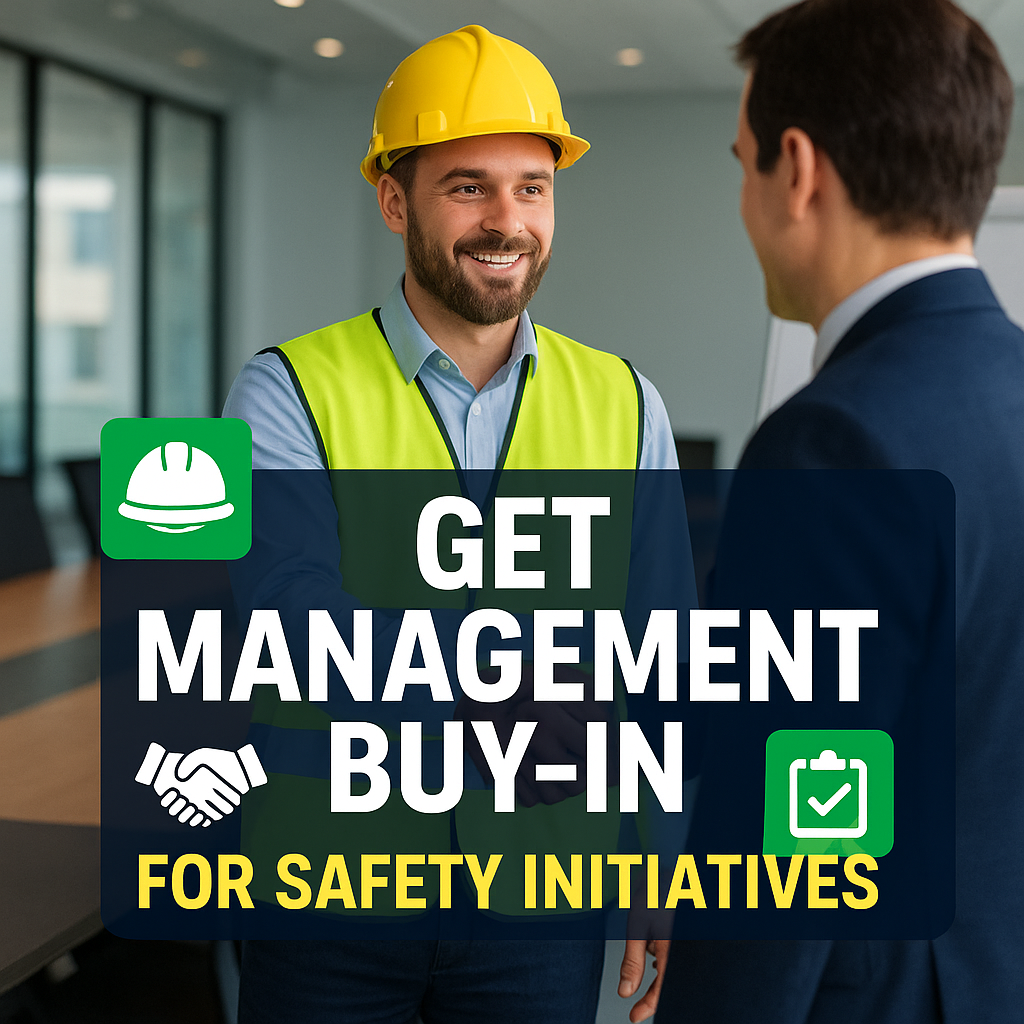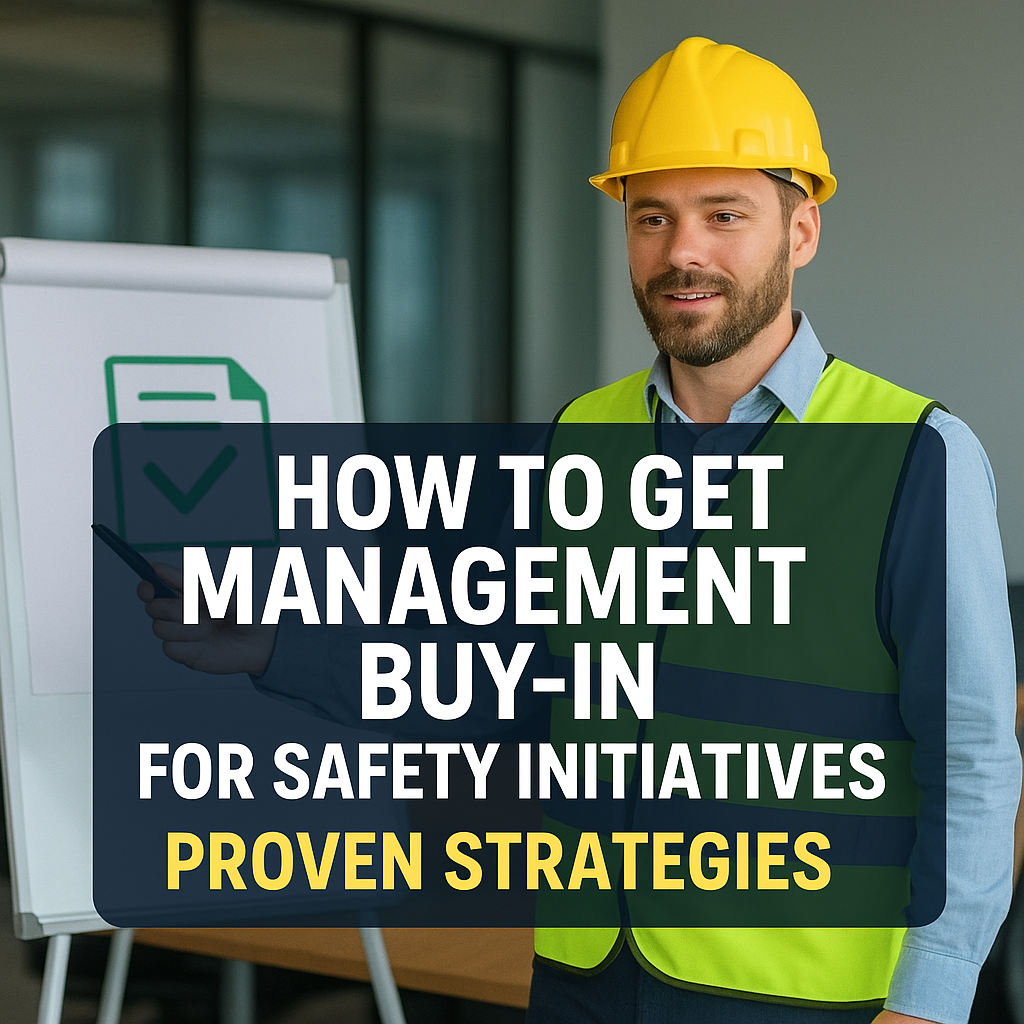How to Get Management Buy-In for Safety Initiatives is one of the most important challenges safety professionals face. Even the best safety plans, training programs, or equipment upgrades will fall flat if leadership doesn’t support them.
According to the National Safety Council (dofollow), effective safety management systems require visible and ongoing commitment from top leadership. Without that commitment, safety becomes an afterthought, and incident rates rise.

Securing management buy-in is not just about asking for money—it’s about aligning safety with business goals and showing its value in reducing costs, improving morale, and protecting reputation.
Understanding Management’s Perspective
Before you can master how to get management buy-in for safety initiatives, you need to understand what managers care about.
Leaders focus on:
- Costs and ROI – How does this save money or reduce risks?
- Productivity – Will this slow us down or make us more efficient?
- Legal and Regulatory Compliance – Are we avoiding fines and liability?
- Reputation – How will this look to customers or the public?
- Employee Satisfaction – Will this improve morale and retention?
If you can’t connect safety proposals to these goals, you’ll struggle to gain traction.
How to Get Management Buy-In for Safety Initiatives: Proven Strategies
Here’s your step-by-step guide on how to get management buy-in for safety initiatives that will actually succeed.

1. Speak Their Language
Skip the technical jargon and focus on business impacts.
- Quantify the cost of injuries (lost time, claims, training replacements).
- Estimate ROI of prevention (savings on insurance, avoiding fines).
- Highlight how safety reduces production delays from incidents.
- Show how strong safety records attract customers and talent.
Managers want solutions, not lectures.
2. Use Data and Evidence
Backing your case with hard data builds credibility.
- Present your company’s injury and incident trends.
- Compare industry benchmarks to show gaps.
- Use case studies of other companies saving money through safety.
- Share findings from internal hazard assessments.
Example: “Reducing ladder falls could save us $50,000 annually in lost time and claims.”
3. Align Safety with Business Goals
Safety should not be seen as competing with production—but supporting it.
- Explain how reducing injuries improves uptime and schedules.
- Show how training reduces errors and rework.
- Highlight the link between safety culture and employee engagement.
- Connect safety to quality and customer satisfaction.
When safety aligns with business goals, it becomes a priority.
4. Engage Leaders Early
Don’t wait to present a fully baked plan.
- Bring managers into the planning stage.
- Ask their input on goals and priorities.
- Invite them to risk assessments or site inspections.
- Include them in safety committee meetings.
Collaboration builds ownership and reduces resistance.
5. Make a Clear, Professional Proposal
Your plan should be as professional as any other business proposal.
- Define clear objectives (reduce recordable injuries by 30%).
- Outline specific actions (training sessions, equipment upgrades).
- Provide timeline and milestones.
- Include budget estimates with cost-benefit analysis.
- Assign responsibilities and metrics.
The more professional your proposal, the more seriously it will be taken.
6. Prioritize High-Impact, Low-Cost Wins
Management is wary of big, expensive changes with uncertain payoffs.
- Start with quick wins that show value.
- Examples: better PPE procurement, short training sessions, improved signage.
- Track and report on results.
Success breeds trust and support for bigger initiatives.
7. Tell Real Stories
Data is great, but stories make it real.
- Share examples of near-misses or injuries that could have been prevented.
- Highlight worker testimonials on safety concerns.
- Use stories to humanize the issue and show leadership responsibility.
Stories engage emotions and ethics, not just numbers.
8. Demonstrate Regulatory Requirements
Show management what the law requires.
- Reference OSHA or local safety regulations.
- Outline penalties for non-compliance.
- Share inspection trends in your industry.
- Offer to review compliance gaps in your organization.
No manager wants fines or legal trouble on their watch.
9. Offer Metrics for Accountability
Leadership wants visibility on outcomes.
- Propose KPIs (training completion rates, incident trends, audit results).
- Suggest regular safety reports to management.
- Commit to tracking ROI on safety investments.
Metrics build transparency and confidence.
10. Build Safety into Company Culture
Safety should not be a project—it should be how you work.
- Encourage leaders to model safe behaviors.
- Include safety goals in performance reviews.
- Recognize and reward safe work practices.
- Make safety part of new-hire onboarding.
A safety-first culture starts at the top.
Common Mistakes to Avoid
While learning how to get management buy-in for safety initiatives, avoid these pitfalls:

- Blaming management – Creates defensiveness.
- Using fear tactics alone – Can backfire without solutions.
- Being too technical – Loses attention.
- Proposing unrealistic budgets – Hurts credibility.
- Failing to follow up – Suggests safety isn’t really a priority.
Approach management as partners in safety.
Benefits of Getting Management Buy-In
Securing buy-in isn’t just a formality. It drives real change:
- More resources for safety training and equipment.
- Stronger enforcement of rules.
- Improved morale—workers see leadership cares.
- Reduced injuries and costs.
- Improved reputation with clients and regulators.
When management leads on safety, everyone wins.
Final Thoughts on How to Get Management Buy-In for Safety Initiatives
Learning how to get management buy-in for safety initiatives is one of the most critical skills for any safety professional. It’s not about “selling” safety—it’s about demonstrating its value, aligning it with business goals, and showing real, human impacts.
If you want to build a truly effective safety program, start by building leadership commitment. With the right approach, you can transform safety from a cost center to a strategic advantage.
For even more tips, check out Building a Safety-First Culture on Residential Construction Sites.

No comments yet